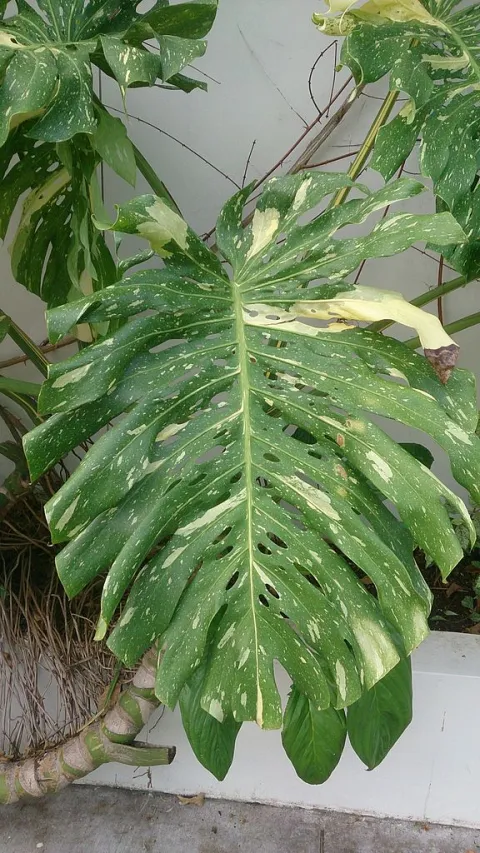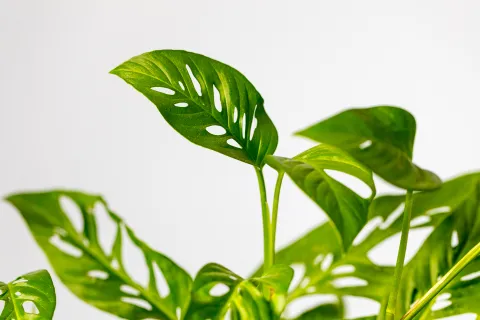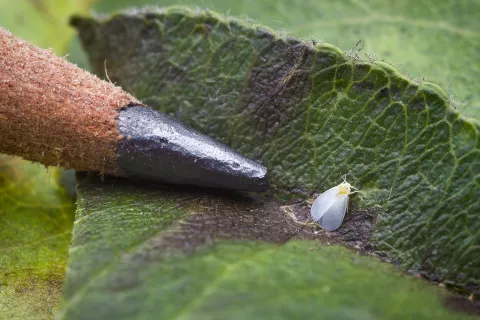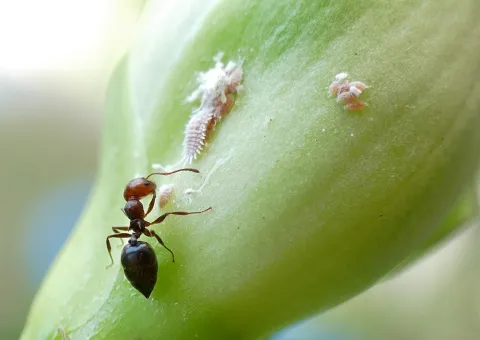Monstera deliciosa variegata, a false philodendron with green and white leaves
It's not only in the kitchen that we revisit the classics. In gardening too. A hybrid variety derived from Monstera deliciosa, Monstera deliciosa variegata also grows in Central America, from Mexico to Guatemala. It has the same varnished, cut leaves. But they are distinguished by their variegated color.
How to recognize Monstera deliciosa variegata?
A hemiepiphytic perennial with a climbing habit, Monstera deliciosa grows up to three meters tall when cultivated in pots. But in its native rainforests, its lianas can exceed 20 meters.
The plant clings to and wraps itself around trees thanks to its brown aerial roots. They also provide nourishment by capturing moisture naturally present in the air.
The tough, heart-shaped leaves grow on a long, hairless petiole. The largest, at the top of the plant, are up to a metre long. Their cut foliage lets light through to the limbs at the base. The latter are smaller and entire. As with monstera dubia, the leaves are multi-colored. But here, no silver highlights. The dark green blades are variegated with white or cream. Some are even completely immaculate.
In the wild, Monstera deliciosa variegata blooms in spring. A pale yellow flower spike, protected by a white spathe, hatches.
The inflorescence then gives rise to a fruit, a green ovoid cone. Its flavor is said to be halfway between pineapple and banana.
But the fruit is the only part you can eat. The rest of the plant is toxic to humans and animals. If your dog or cat nibbles your Monstera variegata, they risk stomach ache and respiratory problems. The sap is also dangerous. It causes skin irritation.
Our maintenance tips
Monstera deliciosa variegata are not difficult to care for. Regular watering, a little moisture, a pot optimized for drainage and a little fertilizer are all that's needed.
Watering
Monstera deliciosa variegata needs a regular supply of water. But, like many plants, the plant cannot tolerate excess. Check that the potting soil has dried on the surface (two to three centimetres) before watering. If this is the case, use non-calcareous water at room temperature. You only need to moisten the root ball, not the soil.
Don't forget to drain off any stagnant water in the saucer or planter. It could rot the roots.
Spray
Monstera deliciosa variegata plants require a high level of humidity. Spray foliage with non-calcareous water, preferably rainwater.
Repotting
In spring, transfer your Monstera deliciosa variegata to a larger pot, so that it can continue to grow.
Monstera deliciosa variegata likes to be cramped. Re-pot only when the roots begin to emerge from the pot.
In a pierced terracotta pot, pour a layer of clay balls. Add a mixture of houseplant potting soil and perlite.
Clean the root ball of your Monstera deliciosa variegata by removing the remains of the previous substrate. Place your specimen in the center of the pot and cover with potting soil. To allow the roots to breathe, pack gently as you go along.
Monstera deliciosa variegata if you like stakes for hanging, don't hesitate to supply one.
Fertilization
You can stimulate the development of your plant during its growth phase, in spring and summer, with fertilizer.
To promote the growth of your monstera deliciosa variegata, use a green plant fertilizer.
Cleaning
Dust prevents leaves from absorbing light and slows photosynthesis. You can use a brush or feather duster to clean the foliage.
Pinch
Pinch your Monstera deliciosa variegata during its growing season.
There may be several reasons why you want to deadhead your Monstera deliciosa variegata: to contain its growth, to multiply the plant or to stimulate its development.
Use your fingers or sharp, disinfected secateurs to cut between two knots.
Wear gloves when handling your plant.
Wear gloves when handling your plant.
Cutting
Cutting is carried out during the strong growth phase, generally in spring and early summer.
Locate a node on the stem with at least one leaf and aerial roots. Cut off two centimetres below with clean, sharp secateurs.
Soak your cutting in a glass of water at room temperature. Only the stem end should be immersed. Change the water every three days to keep it clear.
Place your cutting in a bright spot away from direct sunlight.
Place your cutting in a bright spot away from direct sunlight.
Diseases / Threats
Information
| Family | Araceae - Araceae |
| Type | Monstera - Monstera |
| Species | Monstera deliciosa - Monstera deliciosa |
| Lifecycle | Perennial |
| Foliage | Evergreen |
| Exposures | |
| Substrats | |
| Planting method |
In pots |
| Categories | |
| Tags |
Edible fruit Beginner Large pot Increvable Toxic |
| Origin |
Central America |
| Hardiness (USDA) | 10a |
| Leaf color |
|
| Flower color |
|
| Fruit colors |
|
Discover plants from the same family

Monstera deliciosa
Discover

Monstera 'Thai Constellation
Discover

Monstera albo variegata
Discover

Monstera adansonii
Discover
Find out more
- Chlorophytum 'Variegatum'
- Guzmania monostachia
- Monstera deliciosa
- Monstera albo variegata
- Mini Monstera
- Spathiphyllum 'Diamond variegata'
- These plants with incredible foliage
- Chez Servane, plants for sunshine and good luck
- How to move plants without killing them?
- When should you take out your houseplants?
- Living room, bedroom or bathroom: which houseplant is right for each room?
- Chez Boris: thirty plants and one application in three years
- How do you water your plants on vacation?





















